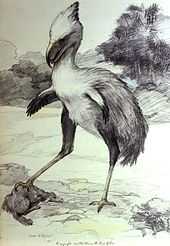Phorusrhacos
| Phorusrhacos Temporal range: Miocene, 20–13Ma | |
|---|---|
 | |
| Reconstructed skull, Royal Ontario Museum | |
| Scientific classification | |
| Kingdom: | Animalia |
| Phylum: | Chordata |
| Class: | Aves |
| Order: | Cariamae |
| Family: | †Phorusrhacidae |
| Subfamily: | †Phorusrhacinae |
| Genus: | †Phorusrhacos Ameghino, 1887 |
| Type species | |
| †Phorusrhacos longissimus Ameghino, 1887 | |
| Synonyms | |
|
Genus synonymy
Species synonymy
| |
Phorusrhacos (pronounced "FOR-rus-RAH-kos") was a genus of giant flightless predatory birds (often referred to as "terror birds") that lived in Patagonia, containing the single species Phorusrhacos longissimus. Their closest living relatives are the much smaller seriemas. They lived in woodlands and grasslands.
Phorusrhacos grew up to 2.5 metres (8.2 ft) tall and weighed approximately 130 kilograms (290 lb).[1] They had enormous skulls up to sixty centimeters long, armed with powerful, hook-tipped beaks. The structure of the beak and the large claws on the toes show that they were carnivorous.
Discovery

Among the bones found in the stratum of the Santa Cruz Formation (now considered as mainly of mid-Miocene date) was the piece of a mandible which Florentino Ameghino discovered in early 1887 and the same year at first described as that of an edentate mammal which he named Phorusrhacos longissimus. The generic name is derived from Greek ~φόρος, (~phoros), an element meaning "bearer" in word combinations, and ῥάκος, (rhakos), "rag" or "wrinkle", probably in reference to the wrinkled jaw surface.[2] When the original derivation was no longer understood, other translations were given, such as the literal translation of "Rag-Thief",[3] and "branch-holder" from the mistaken assumption the name had been intended to be derived from a Greek rhakis, "branch".[4] The specific name means "very long" in Latin, again in reference to the lower jaws. The holotype is the mandible, specimen MLP-118 (Museo de La Plata). In 1889 Ameghino emended the name to a more grammatically correct Phororhacos but the earlier name has priority. In 1891, it was by him recognized to be a bird.[5] Remains are known from several localities in the Santa Cruz Province, of Argentina.
References
- ↑ Alvarenga, Herculano M. F. & Höfling, Elizabeth (2003): Systematic revision of the Phorusrhacidae (Aves: Ralliformes). Papéis Avulsos de Zoologia 43(4): 55-91 PDF fulltext
- ↑ Ben Creisler, "Phorusrhacos “wrinkle bearer (jaw)”: Etymology and Meaning", Dinosaur Mailing List, 26 June 2012 http://dml.cmnh.org/2012Jun/msg00306.html
- ↑ ' Century Dictionary - Phororhacos
- ↑ Editorial footnote by P.L. Sclater in: Lydekker, R., 1893, "On the extinct giant birds of Argentina", Ibis series 6, 5: 40-47
- ↑ Ameghino, F., 1891, "Mamíferos y aves fósiles argentinas. Especies nuevas, adiciones y correcciones", Revista Argentina de Historia Natural 1: 240-259